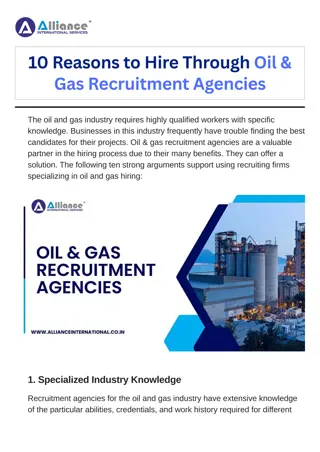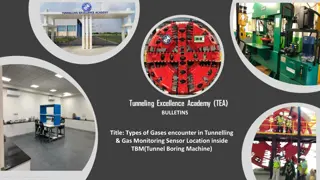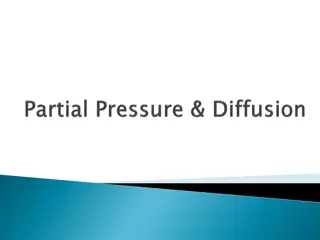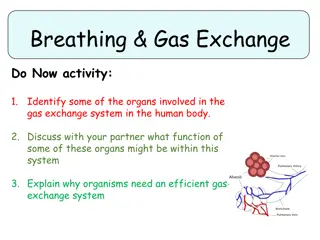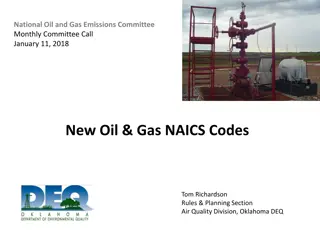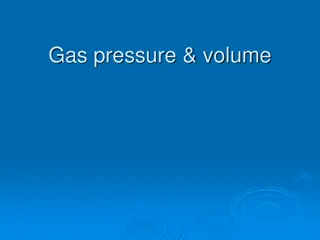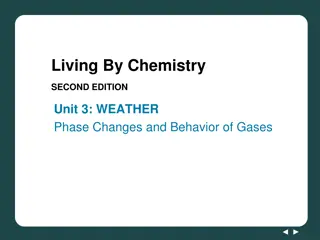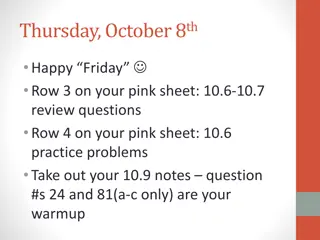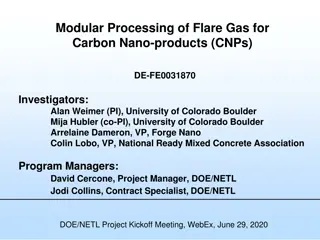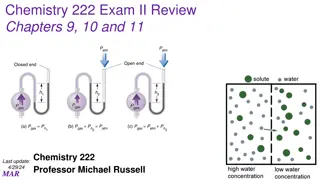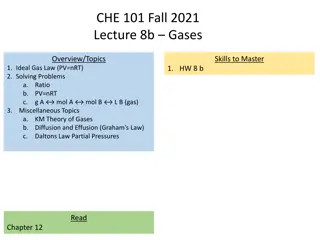Gas Behavior Review
Review key concepts related to the behavior of gases, including characteristics of gases, properties at standard conditions, the kinetic molecular theory, and factors affecting gas pressure. Test your knowledge with true or false questions and learn about gas compression, gas movement in aerosol cans, and gas pressure changes in balloons.
Download Presentation

Please find below an Image/Link to download the presentation.
The content on the website is provided AS IS for your information and personal use only. It may not be sold, licensed, or shared on other websites without obtaining consent from the author.If you encounter any issues during the download, it is possible that the publisher has removed the file from their server.
You are allowed to download the files provided on this website for personal or commercial use, subject to the condition that they are used lawfully. All files are the property of their respective owners.
The content on the website is provided AS IS for your information and personal use only. It may not be sold, licensed, or shared on other websites without obtaining consent from the author.
E N D
Presentation Transcript
Behavior of Gases Review
True or False: One mole of any gas, regardless of size, temperature, or pressure occupies 22.4L? 1. True 2. False 0% 0% True False
True or False: STP is at 0 Kelvin and 760mmHg. 1. True 2. False 0% 0% True False
Which of the following is not a main idea of the kinetic molecular theory of gases? 1. The average kinetic energy of gas particles is proportional to the Kelvin temperature. 2. Gases consist of molecules moving at extremely high velocities. 3. STP is at 0oC and 1atm. 4. The volume of the individual gas molecules is huge compared to the volume that the gas occupies. 0% 0% 0% 0% STP is at 0o C... Gases consist ... The volume of ... The average ki...
If the total atmospheric pressure is 760mmHg, then all of the components of the air (nitrogen, oxygen, ) have a pressure of 760mmHg. 1. True 2. False 0% 0% True False
Why is a gas easier to compress than a liquid or a solid? 1. Its volume increases more under pressure than an equal volume of liquid does. Its volume increases more under pressure than an equal volume of solid does. The space between gas particles is much less than the space between liquid or solid particles. The volume of a gas s particles is small compared to the overall volume of the gas. 2. 3. 4. 0% 0% 0% 0% Its volume increases mo.. The space between gas p... Its volume increases mor... The volume of a gas...
How does the gas propellant move when an aerosol can is used? 1. from a region of high pressure to a region of lower pressure from a region of high pressure to a region of equally high pressure from a region of low pressure to a region of higher pressure from a region of low pressure to a region of equally low pressure 2. 3. 4. 0% 0% 0% 0% from a region of high pr... from a region of high pr... from a region of low pre... from a region of low pre...
If a balloon is squeezed, what happens to the pressure of the gas inside the balloon? 1. It increases. 2. It stays the same. 3. It decreases. 4. The pressure depends on the type of gas in the balloon. 0% 0% 0% 0% It increases. It decreases. It stays the same. The pressure depends o...
As the temperature of the gas in a balloon decreases, which of the following occurs? 1. The volume of the balloon increases. 2. The average kinetic energy of the gas decreases. 3. The gas pressure inside the balloon increases. 4. all of the above 0% 0% 0% 0% all of the above The gas pressure inside ... The volume of the ballo.. The average kinetic ener..
If 4 moles of gas are added to a container that already holds 1 mole of gas, how will the pressure change inside the container? 1. The pressure will be five times higher. 2. The pressure will double. 3. The pressure will be four times higher. 4. The pressure will not change. 0% 0% 0% 0% The pressure will double. The pressure will be five... The pressure will be four... The pressure will not ch...
Which of these changes would NOT cause an increase in the pressure of a contained gas? 1. The volume of the container is increased. More of the gas is added to the container. The temperature is increased. The average kinetic energy of the gas in increased. 2. 3. 4. 0% 0% 0% 0% The temperature is incre... The volume of the conta... The average kinetic ener.. More of the gas is added...
When the Kelvin temperature of an enclosed gas doubles, the particles of the gas ____. 1. move faster 2. strike the walls of the container with less force 3. decrease in average kinetic energy 4. decrease in volume 0% 0% 0% 0% move faster decrease in volume decrease in average kine... strike the walls of the c...
The volume of a gas is doubled while the temperature is held constant. How does the gas pressure change? 1. It is reduced by one half. 2. It does not change. 3. It is doubled. 4. It varies depending on the type of gas. 0% 0% 0% 0% It is doubled. It does not change. It is reduced by one half. It varies depending on t..
In general, for a gas at a constant volume, ____. 1. the pressure of the gas is inversely proportional to its temperature in kelvins the volume of the gas is inversely proportional to its temperature in kelvins the volume of the gas is directly proportional to its temperature in kelvins the pressure of the gas is directly proportional to its temperature in kelvins 2. 3. 4. 0% 0% 0% 0% the pressure of the gas is... the pressure of the gas is... the volume of the gas is ... the volume of the gas is ...
What happens to the partial pressure of oxygen in a sample of air if the temperature is increased? 1. It increases. 2. It stays the same. 3. It decreases. 4. The change cannot be determined. 0% 0% 0% 0% It decreases. It increases. It stays the same. The change cannot be d...
If oxygen is removed from a sample of air as iron rusts, what happens to the total pressure of the air? 1. It increases. 2. It stays the same. 3. It decreases. 4. The change cannot be determined. 0% 0% 0% 0% It decreases. It increases. It stays the same. The change cannot be d...
If the volume of a container of air is reduced by one-half, what happens to the partial pressure of oxygen within the container? 1. It is reduced by one- half. 2. It does not change. 3. It is doubled. 4. It is reduced by one- fourth. 0% 0% 0% 0% It is doubled. It does not change. It is reduced by one-half. It is reduced by one-fourth.




